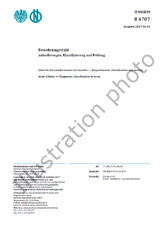We need your consent to use the individual data so that you can see information about your interests, among other things. Click "OK" to give your consent.

ÖNORM EN 10228-3
Non-destructive testing of steel forgings - Part 3: Ultrasonic testing of ferritic or martensitic steel forgings
Translate name
STANDARD published on 1.9.2016
The information about the standard:
Designation standards: ÖNORM EN 10228-3
Publication date standards: 1.9.2016
SKU: NS-753038
The number of pages: 25
Approximate weight : 75 g (0.17 lbs)
Country: Austrian technische Norm
Category: Technical standards ÖNORM
The category - similar standards:
Annotation of standard text ÖNORM EN 10228-3 :
Diese Europäische Norm legt die Methodik für die manuelle Impulsecho-Ultraschallprüfung von Schmiedestücken fest, die aus ferritischem oder martensitischem Stahl gefertigt sind. Mechanisierte Abtastverfahren wie die Tauchtechnik dürfen angewendet werden; darüber sollte jedoch eine Vereinbarung zwischen Besteller und Lieferer getroffen werden. Dieser Teil der EN 10228 gilt für vier Typen von Schmiedestücken, die nach ihrer Form und nach dem Herstellverfahren eingeteilt sind. Die Typen 1, 2 und 3 umfassen im Wesentlichen einfache Formen. Typ 4 umfasst komplexe Formen. Dieser Teil der EN 10228 gilt nicht für: - Gesenkschmiedestücke; - Schmiedestücke für Turbinen- und Generatorrotoren. Die Ultraschallprüfung von Schmiedestücken aus austenitischem und austenitisch-ferritischem nichtrostendem Stahl ist Gegenstand von Teil 4 der EN 10228.
We recommend:
Technical standards updating
Do you want to make sure you use only the valid technical standards?
We can offer you a solution which will provide you a monthly overview concerning the updating of standards which you use.
Would you like to know more? Look at this page.



 Cookies
Cookies
